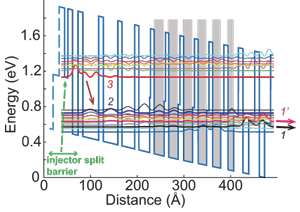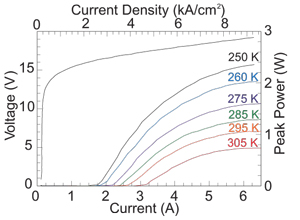- News
24 May 2011
Short-wavelength quantum cascade lasing without antimony
The Institute for Quantum Electronics at ETH-Zürich has achieved short-wavelength performance (near 3μm) in quantum cascade lasers (QCLs) without using antinomy (Sb) [A. Bismuto, M. Beck, and J. Faist, Appl. Phys. Lett., vol98, p191104, 2011].
Up to now, QCLs have needed to contain Sb to push wavelengths below 3.6μm. However, commercial producers would prefer not to use this material in their devices.
Professor Jerome Faist, the leader of the research team, comments: “Sb is a relatively difficult material to control and is not so commonly used in epitaxy. It also makes re-growth more difficult if one wants to make buried heterostructures.” Faist was part of the Bell labs team and lead author of the pioneering paper on QCLs published in 1994.
The ETH-Zürich team sees environmental monitoring applications for QCLs in the 3μm region since this range contains the fundamental frequencies for the stretching modes of C–H, N–H, and O–H bonds that abound in materials of interest. “These absorption lines can be several orders of magnitude stronger than the overtone and combination bands in the near infrared (NIR), permitting the measurement of extremely low concentrations using compact and relatively simple systems,” researchers comment. High-powered QCL devices could also be used for back-scattering detection and other radar-like light detection and ranging (LIDAR) imaging methods.
 The active region (Figure 1) of the Sb-free QCL epitaxial structures were produced on n-type indium phosphide substrates using solid-source molecular beam epitaxy (MBE). The active region consisted of strain-compensated layers of indium gallium arsenide (In0.72Ga0.28As), indium aluminum arsenide (In0.52Al0.48As), and AlAs arranged in 30 periods of 37 layers. One reason to use binary AlAs compound barriers is to eliminate the alloy scattering of ternary materials such as AlAsSb (or InGaAS). Two 200nm confinement layers of InGaAs sandwiched the active region.
The active region (Figure 1) of the Sb-free QCL epitaxial structures were produced on n-type indium phosphide substrates using solid-source molecular beam epitaxy (MBE). The active region consisted of strain-compensated layers of indium gallium arsenide (In0.72Ga0.28As), indium aluminum arsenide (In0.52Al0.48As), and AlAs arranged in 30 periods of 37 layers. One reason to use binary AlAs compound barriers is to eliminate the alloy scattering of ternary materials such as AlAsSb (or InGaAS). Two 200nm confinement layers of InGaAs sandwiched the active region.
Figure 1: Conduction band diagram of a period of the active region at an average field of 120kV/cm. Moduli squared of the relevant envelop wave functions are shown. Light gray is used to show doped wells. Part of the previous active region period is shown as a dashed line.
Cladding layers (2μm and 1μm n-InP, followed by 100nm highly doped InGaAs) were grown using metal-organic chemical vapor deposition (MOCVD).
The cascade structure was based on traditional bound state-to-continuum transitions with an enlarged lower mini-band designed to extract carriers efficiently. The strain of the structure was analyzed using x-ray analysis. The AlAs layers had 3.5% compressive strain, with respect to InP, and the InGaAs layers were 1.3% in tension. However, the overall strain was less than 0.1%.
The epitaxial material was processed into standard 10–20μm-long ridged laser devices. Insulation was provided by silicon dioxide; thinning to 200μm was performed to improve thermal conductivity, along with electroplating the ridge with a 4μm gold layer.
 The cleaved devices were mounted on copper heatsinks, epi-side up. The back facet was coated with a highly reflective combination of aluminum oxide (Al2O3), titanium and gold. When the device was placed on a Peltier cooler, Watt-level emission (Figure 2) was observed at room temperature, performance that is “comparable to what was observed for Sb-containing QCLs”, according to the researchers. Threshold currents as low as 3.6kA/cm2 were also achieved at room temperature, along with a slope efficiency of more than 600mW/A.
The cleaved devices were mounted on copper heatsinks, epi-side up. The back facet was coated with a highly reflective combination of aluminum oxide (Al2O3), titanium and gold. When the device was placed on a Peltier cooler, Watt-level emission (Figure 2) was observed at room temperature, performance that is “comparable to what was observed for Sb-containing QCLs”, according to the researchers. Threshold currents as low as 3.6kA/cm2 were also achieved at room temperature, along with a slope efficiency of more than 600mW/A.
Figure 2: Pulsed power–voltage–current characteristics of a high-reflection-coated 4.75mm-long and 18μm-wide laser for different heat-sink temperatures.
Temperature-dependent measurements between 250K and 350K showed a shift in wavelength from around 3.25μm to 3.35μm, more precisely a shift rate/tuning coefficient around 0.98nm/K. Characteristic temperatures for the threshold current (T0) and slope efficiency (T1) were 100K and 70K, respectively. These figures are also comparable with those of Sb-containing QCLs.
The author Mike Cooke is a freelance technology journalist who has worked in the semiconductor and advanced technology sectors since 1997.
